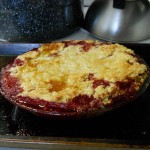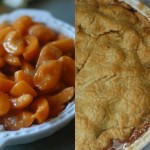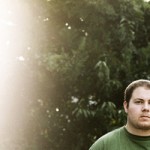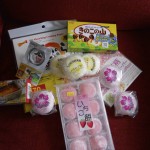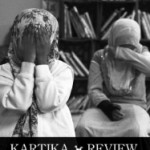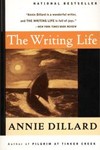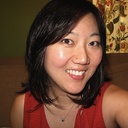 Up next in the “(private)” MFA series is Christine Lee Zilka. We met recently on Twitter, partly through a mutual friend, partly because I knew (from research a while back) that she was editor-at-large of Kartika Review before I submitted my essay. Hooray for the wonders of social media. Somehow, on Twitter, the automatic Bay Area radar kicked in, and we discovered that we’d attended this school at the same time, lived in adjacent dorms, both majored in English, but never met each other. (And really, being an Asian English major meant that we probably would have seen each other in classes at one time or another.) Christine blogs here about her novel-in-process, and she’s got a few pieces of writing coming out soon. I’m really looking forward to reading more of her work.
Up next in the “(private)” MFA series is Christine Lee Zilka. We met recently on Twitter, partly through a mutual friend, partly because I knew (from research a while back) that she was editor-at-large of Kartika Review before I submitted my essay. Hooray for the wonders of social media. Somehow, on Twitter, the automatic Bay Area radar kicked in, and we discovered that we’d attended this school at the same time, lived in adjacent dorms, both majored in English, but never met each other. (And really, being an Asian English major meant that we probably would have seen each other in classes at one time or another.) Christine blogs here about her novel-in-process, and she’s got a few pieces of writing coming out soon. I’m really looking forward to reading more of her work.
1. Did you go through an MFA program? If so, how was it structured?
I went to Mills College for my MFA; the coursework was a balance of craft+literature classes and workshops. I don’t think Mills is necessarily any different from other MFA programs–but I did appreciate the practice of including reading along with writing as discipline.
The breakdown of requirements was/is as follows:
4 writing workshops
3 literature courses (including up to 2 classes on craft)
3 elective credits
1 thesis class
As a two year (four semester) program, this list works out to one workshop per semester, two of which had to be in the genre of specialty (creative non-fiction, fiction, or poetry) and a courseload of 2-3 classes per semester. We assembled our thesis team (an advisor and a reader) at the beginning of our second year–and we met with our advisor regularly throughout the second year to touch base on the progress of our manuscripts.
Mills does NOT read prose thesis manuscripts longer than 90 pages (or was it 120 pages)–either way, it is nowhere near book length, for better and for worse).
I decided to stretch my MFA out to three years–and because I unexpectedly got sick and had to withdraw for a semester, I ended up taking 3.5 years.
2. If you were to design your own private MFA for yourself—either before or after going through your own MFA program—what would it look like, and why? What would be your goals? How would you challenge yourself, solicit feedback, create a writing community?
As you can see with the MFA requirements above, it’s possible to replicate the MFA educational structure: you can take workshops on a regular basis, establish a writing group, read books and get a reading group together to critique the works (and if you so desire, go so far as to discuss them as a writer–from a craft perspective). There are books like Janet Burroway‘s “Writing Fiction: A Guide to Narrative Craft” and John Gardner’s “The Art of Fiction” and then there is Jane Smiley’s “13 Ways of Looking at the Novel” as reference.
But you see–I didn’t go to an MFA program purely for the workshops and classes–I went to establish a writing life, find mentors, and find a community of writers. I had denied myself a life as a writer for so long that I needed a very clear change in my environment, and that is something the MFA program provided me. If you can’t/won’t attend an MFA program, you can still achieve this by applying to writing workshops and conferences whereby you travel to a different geography or climate and immerse yourself as a writer for a week or two or three.
Summer writing workshops/conferences aren’t cheap, but they are still cheaper than the cost of most MFA programs without scholarship. And summer conferences are certainly more transient (1-2 weeks long) and can accommodate a fulltime working schedule. (Even filling out the applications for such summer programs is an enlightening process–you will be asked questions on “what you hope to gain from the experience” and possible questions asking you to detail what it is you write about. All good things to know about yourself as a writer).
I went to Squaw, and it helped me shift direction. It was the place I decided I wanted to pursue an MFA. And of course there are other writing conferences–like Napa Valley Writers Workshop, which is so wonderful and craft-focused with amazing writing workshop leaders each summer. And VONA. I have made writer friends for life at each of these summer workshops, and they are still an invaluable part of my community.
One of the pitfalls of an MFA program is that you are exposed to the same feedback for the entirety of your education–the same peers, the same professors, even if you try hard to make sure you take classes with different people and instructors. I have told people in MFA programs to expand their community, and go to workshops and conferences.
And I’d advise the same for people not within an MFA program–go to different workshops and conferences, find your people. Apply and go to Squaw, to Napa Valley, to VONA. Go to your neighborhood UC Extension or if you’re in NYC, Gotham Writers Workshop. Get your feedback there, make friends, gain mentorship.
There is a lot of pushback on Twitter and FB in the writing community–seeing these things as “distractions,” but for me they are another inlet of community. I have made friends and have a support system on these networks. In fact, that’s how you and I met–! Facebook and twitter are helpful ways to gain community and support and insight–just so long as of course you keep your writing routine up.
Blogging is also helpful–a way to keep in touch with others, exercise your craft. Get your feedback. Make connections. Throw out your questions and doubts to the universe on your blog, and most likely than not, you’ll get a response.
As for goals–I think that’s a personal matter. I’m an extremely slow writer, and I don’t think the two years of an MFA program is enough time for me to finish a book-length manuscript. And quite honestly, I’d rather spend two years writing 75 pages that I am proud to have written. But yes, you should have goals–whether that is a collection
of stories, or 3 stories…or if the goal is to just to have sent your writing out to a number of litmags.
But don’t make your goals ones that are dependent on others. Like, don’t make it your goal “to get published.” So much of being published is not contingent on you, but on others–on others’ subjective reaction to your writing and their own timelines. Send your writing out, and make it a goal to submit to 30 literary magazines, but don’t make it a goal to get published in 5 literary magazines.
Enjoy the process. Write. Read. It doesn’t have to take two years. It can take three and a half years. Or five.
3. What have you read lately that’s just blown you away?
Mat Johnson‘s Pym: Read it for the voice! And you’ll laugh, even as the story investigates the idea of race that will stimulate both cortex and funny bone function. Oh, and if you’re a Poe fan, then this is a must-read for sure. Vida by Patricia Engel. Best short story collection of 2010! Sabina is the recurring protagonist throughout the entire collection–and her voice and character: pitch-perfect and whipsmart.
I recently read an amazing story on “The Lazarus File” by Matthew McGough in The Atlantic. Amazing read about a cold case brought to life by DNA evidence–and so the article is as much about the case as how DNA evidence has revolutionized homicide investigation. The article is excellent journalism–but in particular, I admired the way in which McGough structured his article.
I’m a big Haruki Murakami, Jeffrey Eugenides, Junot Díaz and John Irving fan. I also love Nicole Krauss, whose book Great House came out last year. I loved her book The History of Love, and Great House addresses many of the same themes. The structure of the book is atypical and precarious (can you tell I’m obsessed with novel structure?) but the characters hold the novel together–they were characters I knew I could hang with for hundreds of pages.
Alexander Chee has an essay called “Fanboy” online at The Morning News. Comic books are amazing–if you walk into a comic bookstore, the place is full of disenfranchised men, and men who yearn for power vicariously through comic book heroes. But Alexander Chee, in this essay, examines comic books from a multitude of perspectives, from his biracial isolation, to U.S. imperialism.
And my mom just gave me a copy of Please Look After Mom by Kyung-Sook Shin. It’s just been released in English translation. My mom said the novel blew her away when she read it in the original Korean years ago. I just started reading it–but already, I’m so impressed. The entire novel is written in the always risky second-person point of view.
4.What are you working on now? Do you have anything coming out? Can you say a little bit more about it here?
I’m working on a novel. An excerpt of my novel will appear in an anthology entitled “Men Undressed: Women Writers on the Male Sexual Experience“, available in October 2011. The anthology is comprised of pieces by women writers writing sex scenes from the male perspective–a response to our literary canon comprised of men like Flaubert to D.H. Lawrence to Philip Roth writing sex scenes from the female perspective. The anthology’s call for submissions spurred me to write a long overdue sex scene in my novel. I can’t wait to read all the pieces within the anthology! It’ll be out via Other Voices/DZANC books this Fall.
I’ve also got a short story forthcoming in Kweli Journal. The piece is called “Ume,” and it was a piece that used to be twice as long and told from the point of view of both a father and a son–but I edited it down for length, to just the father’s POV. It worked, I think, much better as a short piece in that way. The piece is particularly meaningful for me because it was the first piece I wrote after I had my stroke, from which I took about 2 years to recover. There was nothing wrong with me on a musculature level, but I lost my short term memory capabilities, and I had a lot of cognitive issues that prevented me from reading a story, let alone writing one. By the time I heard from Kweli, I’d sent “Ume” out to about 50 litmags, and I’d almost lost hope that I would find this story a home. I’m so glad Kweli took it in, and I’m really glad that the home is Kweli Journal, which is a fantastic literary journal focusing on writers of color.
Thanks for participating, Christine! I’ve learned a lot from your post, and I love the idea of the MFA’s purpose “to establish a writing life.” I also like the idea that the goal of being a writer is not necessarily “to get published”–behind this ideal is, I think, the drive to appreciate the writing life for what it is. I’m a huge fangirl of Murakami and Diaz (and Chee) as well. I hope we’ll get to meet someday.
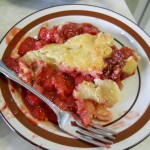 But it was pie, it was strawberry, it was eaten. It was mine. It was ours, to share with our girls and our guests. And, the next day, it was a spoonful for breakfast.
But it was pie, it was strawberry, it was eaten. It was mine. It was ours, to share with our girls and our guests. And, the next day, it was a spoonful for breakfast.
